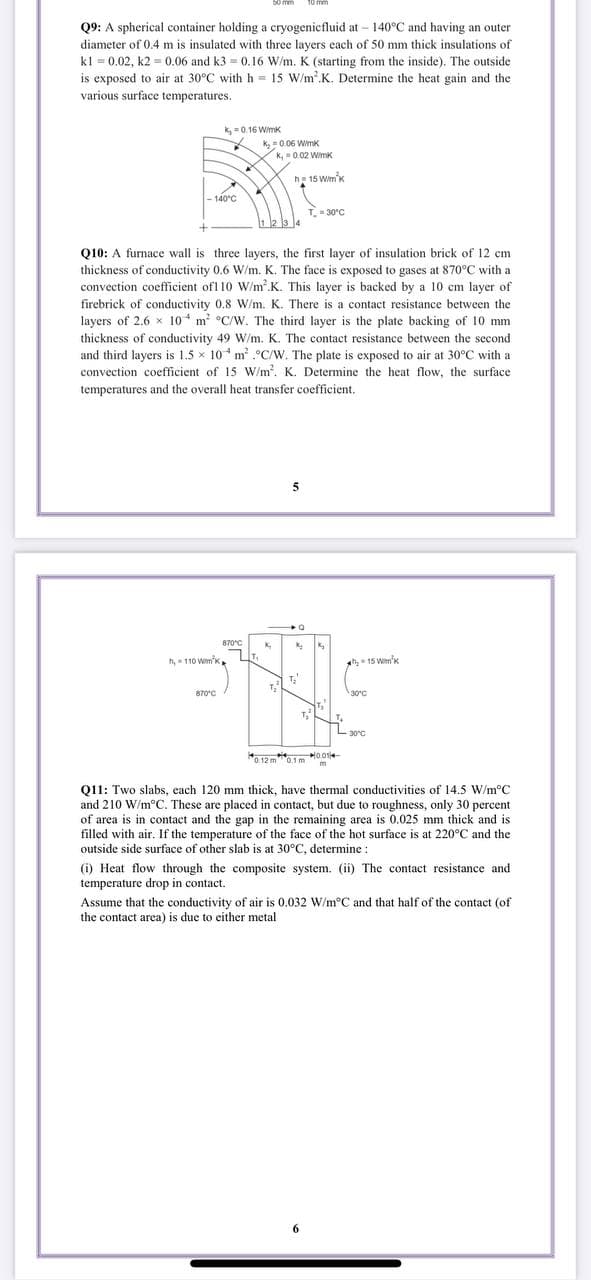Q9: A spherical container holding a cryogenicfluid at – 140°C and having an outer diameter of 0.4 m is insulated with three layers each of 50 mm thick insulations of kl = 0.02, k2 = 0.06 and k3 = 0.16 W/m. K (starting from the inside). The outside is exposed to air at 30°C with h = 15 W/mK. Determine the heat gain and the various surface temperatures. k=0.16 Wimk * k=0.06 Wimk K,=0.02 Wimk he 15 Wimk - 140°c T 30°C
Q9: A spherical container holding a cryogenicfluid at – 140°C and having an outer diameter of 0.4 m is insulated with three layers each of 50 mm thick insulations of kl = 0.02, k2 = 0.06 and k3 = 0.16 W/m. K (starting from the inside). The outside is exposed to air at 30°C with h = 15 W/mK. Determine the heat gain and the various surface temperatures. k=0.16 Wimk * k=0.06 Wimk K,=0.02 Wimk he 15 Wimk - 140°c T 30°C
Principles of Heat Transfer (Activate Learning with these NEW titles from Engineering!)
8th Edition
ISBN:9781305387102
Author:Kreith, Frank; Manglik, Raj M.
Publisher:Kreith, Frank; Manglik, Raj M.
Chapter2: Steady Heat Conduction
Section: Chapter Questions
Problem 2.30P: 2.30 An electrical heater capable of generating 10,000 W is to be designed. The heating element is...
Related questions
Question

Transcribed Image Text:50 mm
10 mm
Q9: A spherical container holding a cryogenicfluid at – 140°C and having an outer
diameter of 0.4 m is insulated with three layers each of 50 mm thick insulations of
kl = 0.02, k2 = 0.06 and k3 = 0.16 W/m. K (starting from the inside). The outside
is exposed to air at 30°C with h 15 W/m.K. Determine the heat gain and the
various surface temperatures.
k-0.16 Wimk
K0.06 Wimk
k, = 0.02 Wimk
h 15 Wim'k
- 140°C
T=30°C
Q10: A furnace wall is three layers, the first layer of insulation brick of 12 cm
thickness of conductivity 0.6 W/m. K. The face is exposed to gases at 870°C with a
convection coefficient ofl 10 W/m.K. This layer is backed by a 10 cm layer of
firebrick of conductivity 0.8 W/m. K. There is a contact resistance between the
layers of 2.6 x 10 m °C/W. The third layer is the plate backing of 10 mm
thickness of conductivity 49 W/m. K. The contact resistance between the second
and third layers is 1.5 x 10 m².°C/W. The plate is exposed to air at 30°C with a
convection coefficient of 15 W/m. K. Determine the heat flow, the surface
temperatures and the overall heat transfer coefficient.
870°C
n, 110 Wim'k
15 Wim'k
870°C
30°C
30°C
12 m01m o
011: Two slabs, each 120 mm thick, have thermal conductivities of 14.5 W/m°C
and 210 W/m°C. These are placed in contact, but due to roughness, only 30 percent
of area is in contact and the gap in the remaining area is 0.025 mm thick and is
filled with air. If the temperature of the face of the hot surface is at 220°C and the
outside side surface of other slab is at 30°C, determine:
(i) Heat flow through the composite system. (ii) The contact resistance and
temperature drop in contact.
Assume that the conductivity of air is 0.032 W/m°C and that half of the contact (of
the contact area) is due to either metal
6.
Expert Solution
This question has been solved!
Explore an expertly crafted, step-by-step solution for a thorough understanding of key concepts.
This is a popular solution!
Trending now
This is a popular solution!
Step by step
Solved in 4 steps with 8 images

Knowledge Booster
Learn more about
Need a deep-dive on the concept behind this application? Look no further. Learn more about this topic, mechanical-engineering and related others by exploring similar questions and additional content below.Recommended textbooks for you

Principles of Heat Transfer (Activate Learning wi…
Mechanical Engineering
ISBN:
9781305387102
Author:
Kreith, Frank; Manglik, Raj M.
Publisher:
Cengage Learning

Principles of Heat Transfer (Activate Learning wi…
Mechanical Engineering
ISBN:
9781305387102
Author:
Kreith, Frank; Manglik, Raj M.
Publisher:
Cengage Learning